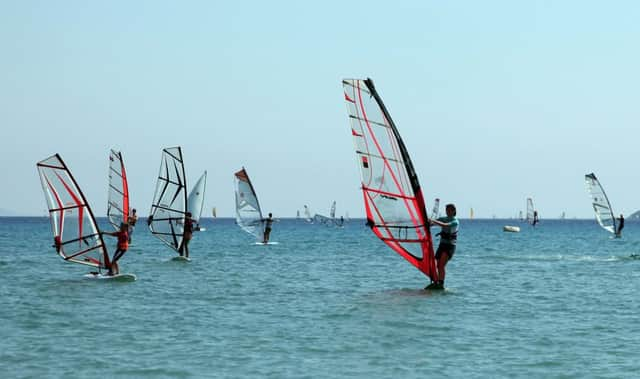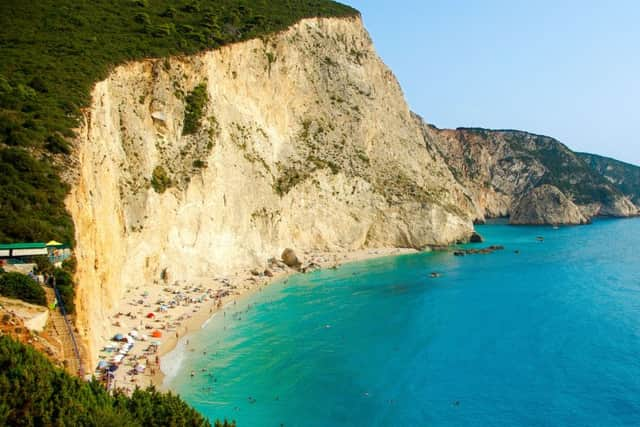Travel review: Greek Islands - A sea of tranquility


There are no sprawling resorts and strips of neon nightclubs, just picture-perfect towns occupied by a few tavernas, shops and hotels. It’s a far cry from the stereotypical image of a Greek getaway. Lefkas might be the fourth largest Ionian Island, but it’s the unspoilt stuff of imaginations.
Our accommodation is the perfect example of the trademark seclusion of Lefkas. From our private poolside terrace, we can sit with a glass of the local wine, enjoying views of the capital, Lefkas Town, and across the water to the mainland.
Advertisement
Hide AdAdvertisement
Hide AdOnce a working windmill, the stone building has been transformed into the perfect hideaway: the top floor is dominated by a huge bedroom, and a kitchen, bathroom and dining area occupy the ground floor. With the nearest neighbour a few hundred metres away, and the pool hidden from view, it’s the perfect place to relax and – literally – get away from it all.


But it’s not just the peace and quiet that makes Lefkas different from other islands. Just 21 miles long and nine miles wide, Lefkas – which some people also refer to as Lefkada – was a peninsula of Arcanania until it was split by a 28m canal excavated in 640BC.
Now you come and go across a swing-bridge that joins the mainland to the island, enjoying the feeling and culture of being on a Greek island with the freedom to easily explore further afield. Not that there isn’t plenty to do on Lefkas.
Divided by the towering Mount Stavratos, each corner of the island has its own character – from the sheltered east coast with family-friendly beaches, to the crashing waves and steep cliffs of the dramatic west coast, with luscious rolling countryside dotted with deserted windmills and watermills in between. It’s here, inland, where you can really soak up the unbelievably slow pace.
Advertisement
Hide AdAdvertisement
Hide AdKavalos, the sleepy hamlet where our windmill lies, is the perfect example. From morning to evening, nothing seems to change, except for the addition of a few Greek men sitting outside what appears to be a bar, drinking coffee and watching the world go by.
The island’s capital, Lefkas Town, is far from a bustling metropolis. We accidentally arrive during the siesta and wander around the narrow streets as if in one of those dreams where everyone has suddenly disappeared.
The low-key nature of the island brings its own low-key tourist attractions. Near to the windmill, we hunt for the ‘Melissa Gorge’, with a paved route running past ruined watermills and windmills. After three days of searching for the ‘gorge’, we finally find it, directed from the road by a tiny sign facing in just one direction.
On the other side of the island, just outside the ‘tourist resort’ of Nidri, is a picturesque harbour filled with boats clamouring to take people on tours of the nearby tiny islands and the Rachi waterfalls. Don’t expect anything too spectacular, just a slow trickle with a small puddle at the bottom.
Advertisement
Hide AdAdvertisement
Hide AdFrom Nidri, you can hire your own little vessel. Boating was just the start of quite a lot of water-orientated action on Lefkas for us. The southern resort of Vassiliki is internationally recognised as one of the leading windsurfing resorts in Europe.
We spent an afternoon trying to get the hang of it and a few hours later our legs are aching, but I can see why people get addicted.
A tour of the famous west coast takes in some impressive sights such as Kathisma Beach, where tourists can paraglide from a nearby hill onto the shore, and Porto Katsiki, where steps lead down to perfect white sands backed by high cliffs.
We don’t quite make it as far as Lefkada Cape, described by Byron as the “lover’s refuge”, where white cliffs rise 60m out of the beautiful surf below. It’s said that it was here that ancient poet Sappho threw herself into the sea after being spurned by lover Phaon.
Advertisement
Hide AdAdvertisement
Hide AdThere are many more historical sites on the mainland near Lefkas, from the ancient city of Nikopolis, built in 31BC to commemorate the victory of Octavius over Antony and Cleopatra at the battle of Aktion, to Nekromanteion, on a hill above what in ancient times was the mouth of the River Acheron, the mythical River Styx, gateway to the underworld.
It’s clear there’s plenty to do and not enough time to do it all. But with some local fish on the barbecue and a chilled bottle of wine, we enjoyed just sitting on the windmill terrace admiring the twinkling lights of Lefkas Town.
• Ellen Manning was a guest of Greece villa specialist GIC The Villa Collection (www.gicthevillacollection.com; 020 8232 9780) which offers a seven-night stay at Villa Milos (sleeps two) on Lefkas from £802pp (two sharing). The price includes self-catering accommodation, return flights (Gatwick), car hire and welcome pack.
For early flights, stay overnight at the Gatwick Airport Travelodge (0871 984 6506, www.travelodge.co.uk) with doubles from £46 (room only).